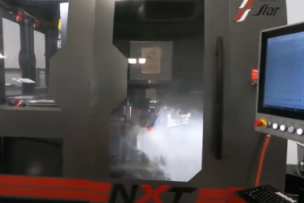Cutting Challenges: Mixed-Matrix Composites and Fiber-Reinforced Composites
It may not be metal, but composites can be successfully cut and produced; you just need to understand the nuances.
New to mixed matrix and fiber-reinforced materials in aerospace? Here’s a primer on how to work with composite materials.
As many industries including aerospace continue to call for increasingly lightweight components, you might find yourself standing in front of a CNC machining center one day wondering, “What is this stuff I’m cutting?”. Tools wear quickly, dust goes everywhere, and machined surfaces are rough, chipped and oftentimes cracked.
What Are Composite Materials?
“Composite materials are essentially a combination of two or more dissimilar materials that are used together in order to combine best properties, or impart a new set of characteristics that neither of the constituent materials could achieve on their own,” writes Dr. Rainer Groh, a research associate in nonlinear structures at the University of Bristol in his Aerospace Engineering blog.
First, it’s a good idea to understand why composites are being used: It’s because they are simultaneously lightweight and strong. Sounds simple enough to understand. However, the devil, when cutting composites, is in the details.
“The matrix is susceptible to oxidation and degradation from excessive heat, and the carbon fibers don’t cut well because they fracture instead of shearing smoothly,” notes American Machinist in an article on carbon fiber-reinforced polymer. “[T]he machining of composites results in a series of brittle carbon-fiber fractures producing dust-like chips that carry away very little of the heat generated by machining.”
Fiber-Reinforced Composites vs. Matrix Composites
Floor beams, stabilizer panels, flight control surfaces, doors and bulkheads—these are just a few of the many composite or laminate parts found in aircraft today, most of which are made of multilayer composite-metal-composite sandwiches or honeycomb-like materials with tough exteriors and almost papery structures within.
However they’re constructed, whatever they’re laminated with in aerospace, there are three classes of fiber-reinforced composites that exist, including ceramic, metal and Kevlar. Similarly, there are three matrix composite classes: phenolic, polyester and epoxy. These materials can be pretty difficult to machine, but with some basic knowledge and a little investment in equipment and tooling, all are quite manageable.
You might have heard composites referred to as CFRP (carbon fiber reinforced plastic), metal matrix composite (MMC), aramid (which is Kevlar), or dozens of other similarly scientific-sounding names. The key is in understanding the differences from working with metal.
“The shift from metallic to composite construction has naturally induced a change in the design methodology of aircraft components,” notes Groh. “It has to be borne in mind that not only the mechanical properties of composites differ from those of metals, but that a whole range of physical and chemical properties are different.”
The shift from metallic to composite construction has naturally induced a change in the design methodology of aircraft components. It has to be borne in mind that not only the mechanical properties of composites differ from those of metals, but that a whole range of physical and chemical properties are different.
Cutting Composites: Dust, Carbon Dust and Filtration Systems
Let’s start with the nasty dust that’s swirling around your head. You don’t want to inhale the stuff. For some applications, flooding machines with cutting fluid can create an abrasive mud that could damage your expensive CNC machine. Some composites soak up water like a proverbial sponge, so applying coolant may actually damage the workpiece if you don’t have the right equipment. In other composite applications, however, coolant can be a very effective method of controlling the dust, improving tool life and improving component finishes.
Another issue to be aware of: Carbon fiber dust has been known to ignite under certain circumstances. Dire warnings aside, the solution is simple enough—any shop routinely cutting composites should invest in a filtration system, one suitable for the type of material being machined. A fairly airtight enclosure is also a good idea, but as long as there’s sufficient vacuum to draw the dust up and out of the work area, there shouldn’t be any problem. Any leftover dust can be cleaned up with a Shop-Vac (just be sure the filter is in good shape). Here are some key best practices for filtering composite dust:
- Check with your machine dealer about the need for a positive pressure spindle as found in graphite cutting machines
- Check with the material supplier as to what size and kind of filtration is needed (there are many variations)
- And check with the customer about the part cleanliness requirements—aircraft manufacturers are usually very particular about the presence of dust and foreign objects (FOD) on machined parts
Tools for Cutting Composite Materials: Put Away the HSS
As far as cutting tools go, you can forget about high speed steel. Composites are generally quite abrasive, and while HSS is tough, it can’t take the abuse of cutting material like sandpaper. If you have only a few parts to machine, solid carbide will work, but you need a very sharp edge (this means coatings are probably out of the question, thanks to the microscopic edge-rounding that comes with all CVD and even most PVD coatings).
The geometry is also important. The relatively steep helix angles on metal-cutting end mills and drills tend to delaminate most composites, which pulls apart the layers and damages the material integrity, similar to what happens when you drill a hole in a piece of fiberglass (even though you might not be able to see it with the naked eye). The best bet is a neutral or reverse helix cutting tool like a router bit for wood or plastic machining, or cutters that have been specially ground for composite work.
So for drill bits, use double-angle points (they look like Batman, with pointy ears on either side of the drill tip) that reduce forces during breakthrough and eliminate splintering—to prevent delamination on the exit surface. Another option is a brad-point drill, familiar to woodworkers. You can also interpolate the hole to size with a neutral rake end mill or router bit.
Composite Material Cutting: Diamonds Are a Machinist’s Best Friend
For higher production quantities, or where edge quality is critical (which is usually the case), polycrystalline diamond-tipped tools and diamond coated tools are the best choice. Brazed or indexable tools are the most widely available and will do an excellent job, but here again, some cutting tool manufacturers offer products specially designed for CFRP and other composites. Evaluate these specific type of cutting tools wherever maximum performance is required.
Whichever approach you take with cutting tools, feeds and speeds will be uncharted territory. For the best results, call your tooling supplier and the material manufacturer for advice, set aside a little time for testing and document everything you do.
Extra Tips for Working With and Cutting Composite Materials
Grabbing on to flimsy composite parts can be challenging, so take a look at vacuum workholding or light-activated adhesives. If heat becomes a problem, try aiming a cold air gun at the work zone.
Here are a few additional composite pointers to get you moving in the right direction:
- Be aware of the underlying composite grain direction and structure, as it may have to be oriented in certain ways to achieve the desired machining results
- Sandwiched material may negate the use of PCD in favor of carbide
- Honeycombed composites, popular in airframe structures, are also subject to a different playbook—here, climb milling is the preferred approach (something that’s often not the case with composites)
It’s a good idea to follow the Boy Scout motto and be prepared: Composite machining is headed your way.
How do you work with composites in your shop? Tell us your cutting horror stories.




Talk to Us!
Leave a reply
Your email address will not be published. Required fields are marked *